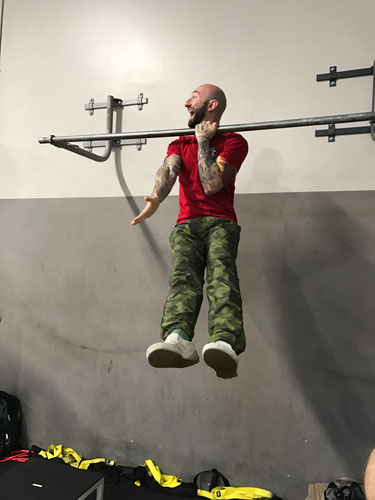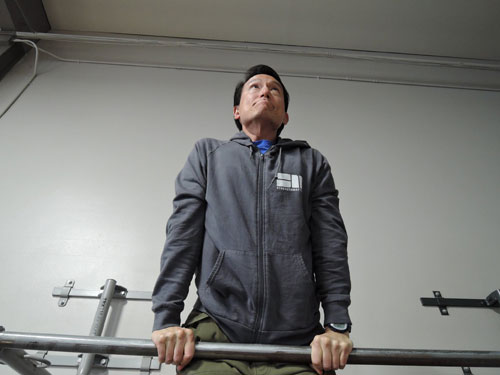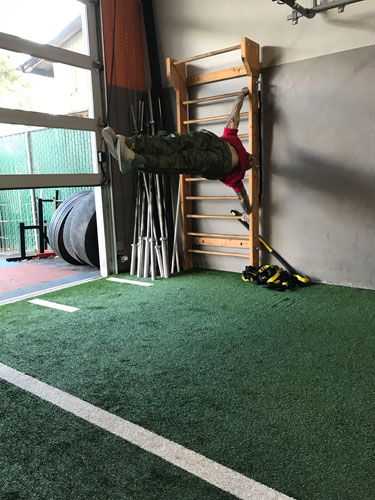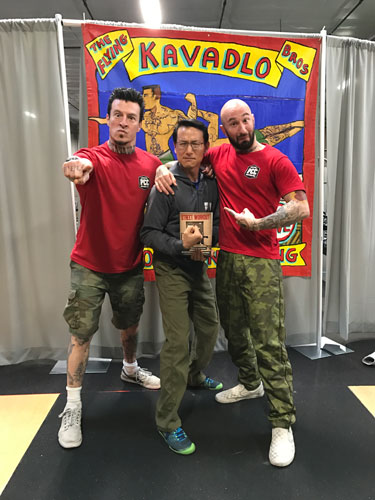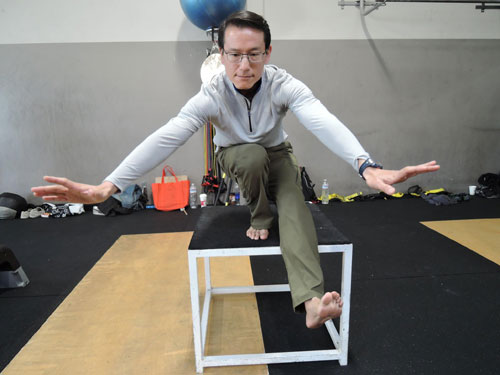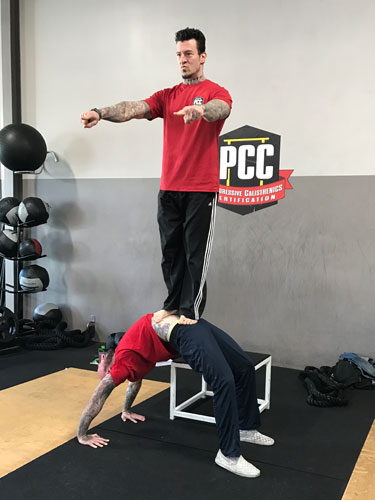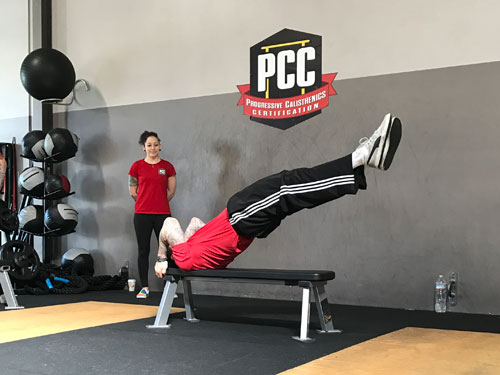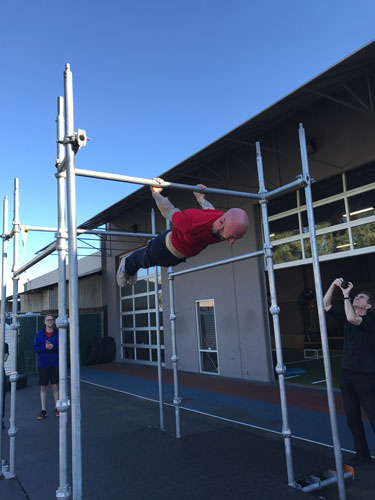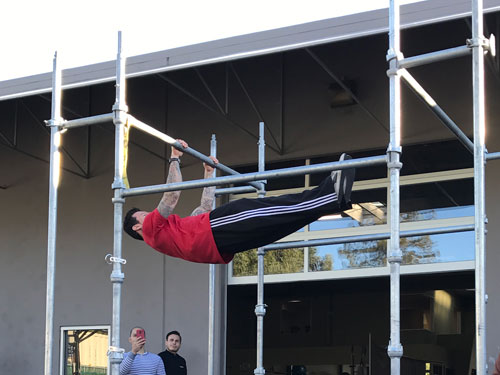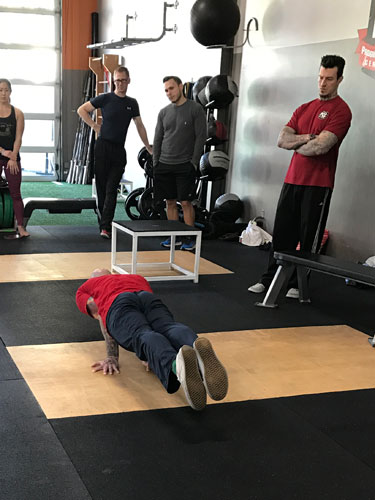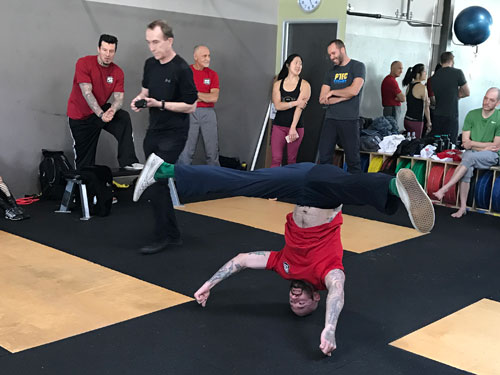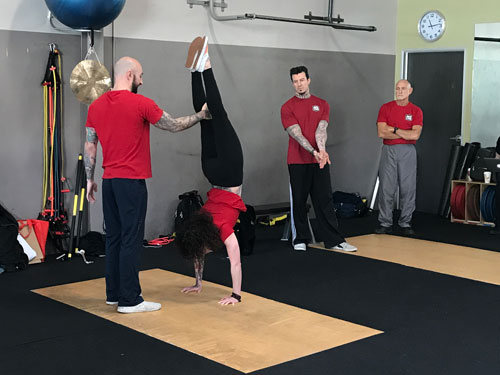It’s the beginning of September, and I ping Mark “Rif” Reifkind, my kettlebell coach and Chief Instructor of Strength Matters, on Facebook. I talk about the problems of my right arm press of 24kg, one of two last problem points as I head into the Strength Matters Kettlebell Certification. Of course, it degrades into defeatist talk at which time I rally and tell him I won’t let him down.
Up to this point, it’s been a 5 year journey. Never have I felt closer to being able to complete a real kettlebell cert, and I finally committed to a cert date and location: Oct 21-23 in NYC at Exceed Physical Culture in Tribeca. With about 1.5 months left, I am attempting to hit all the requirements of the cert and own them by then, so that they do not require excessive effort or energy to just execute and survive. But not all is proceeding to plan; time is running out and I am wondering if I will pass on the cert date or after.
By now, I have been doing the 10 minute Swing Test (1 arm Swing for 10 reps in 15 seconds, rest 15 seconds; switch hands and repeat; continue until you hit 10 minutes) for months; not that it seems easier every time I do it – at least I am recovering well which tells me that I’ve adapted somewhat. This, I feel, is crucial. I want to be adapted to as many of the cert required loads and moves so that I can get through the 3 days without collapsing.
Also, I’ve been doing the Swing Test with the 28kg. Earlier this year when I signed up for the cert, I weighed upwards of 168 lbs and thought that I would have to get through the Swing Test with the 28kg (I’m in the 50-59 age group). Little did I know that I would show up at the cert weighing a measly 141 lbs and could do the Swing Test with the 24kg! This would prove advantageous as spending so much time with the 28kg at the VO2max cadence meant that the 24kg felt light, and I didn’t feel so wiped.
Other cert requirements that I already hit were the Turkish Get Up, Clean, Front Squat, and the Goblet Squat, although it was not testing requirement. While not a testing requirement, there is a Snatch VO2max workout (Snatch 7 reps in 15 seconds, rest 15 seconds; switch hands and repeat; continue until you hit 20 minutes) with the 16kg which is definitely something I would not just want to walk into the cert without preparation, thinking I would just gut through it. In the weeks before, I hit the full 20 min several times, interleaving them with shorter workouts where I stopped due to fatigue or hand problems.
There is another graduating workout which I heard would be a combination of Swings and Goblet Squats. They are done in matching numbers: 1 Swing + 1 Goblet Squat, Rest; 2 Swings + 2 Goblet Squats, Rest; and so on up to 10. Then do it again! So I added a multi-set Goblet Squat workout weekly just to get my quads up to par in case I had to do a squat dominant workout.
The two cert requirements that escaped me were the 24kg 1 Arm Press and Snatch. The easy one to talk about was the Snatch as it was just a build that I had not reached yet, and I did make it to the cert with a few workouts achieving 10/10 at least once. Still, I did not feel like I owned it but with time running out, it would have to do.
The much harder and stressful one was the 24kg 1 Arm Press. For months I had been building up slowly to 5×5/5 with the 16kg, 20kg, and then finally with the 24kg. However, my left arm was much more capable. It could put up the 24kg 5x nearly effortlessly. In stark contrast, my right arm was totally inconsistent. I would run through 5 sets, sometimes varying set by set between 1 and 4 reps. I knew something was deficient, and it wasn’t an energy problem because I often hit a 4 rep set towards the latter half of the 5, after doing a bunch of singles, doubles, and triples.
With Rif’s help, I was finally able to diagnose it as a lat problem, which then related to a tight and overactive right trapezoid that tended to drag the shoulder up when attempting the press. This turned it into a muscle lift and not a whole body lift, at which point my shoulder muscles simply could not make it to 5 reps without failing.
Finally, the week of the cert comes and on Monday of that week I figure out that if I contract both lats (versus only my right lat) before the lift, I could do 5 reps! In fact, I hit it twice! With newly armed confidence, I hop on the plane to NYC and the cert.
Arriving the day before was risky; I would have jet lag to contend with since the cert started (more or less) at 8am each day. Also, I like to get up well before that so that I can have my usual daily Hanna Somatics warm-up, as well as my coffee. However, as circumstances would have it, I got in the day before. I ate a big steak and a large potato to fuel up for the next 3 days. I prepared my backpack for tomorrow:
- 4 rolls of Johnson and Johnson athletic tape – this is the only brand of tape to use. Other brands cannot be ripped by your hands; you need scissors to cut which is annoying.
- Scissors
- Thin workout gloves – wasn’t sure if I would rip my hands.
- Kettlebell wrist guards – in case my wrists got overly bruised, or more recently, scraped to bleeding due to the bell resting there.
- Chalk – had to bring my own brand, didn’t trust anybody elses. Rif’s recommendation: GSC Gym Chalk
- 2 Bananas – refuel whenever possible!
DAY ONE
Day One began a bit drizzly and muggy. But thankfully Exceed had air conditioning in the basement room where we were. I shudder to think if we had to be in their street level workout room which was rumored to never have the A/C on.
Rif led the instruction, with instructors, Ed Cashin, co-founder of Truth Training, and James Breese, CEO/Founder of Strength Matters, helping out.
We did a quick group warm up. As an Original Strength coach, it was great to see Original Strength movements worked into the warm up! Strength Matters has a partnership with Original Strength, and it’s good to see the integration.
Then, we dove right into learning how Strength Matters teaches kettlebells. Swings were taught first with progressions and corrections. After teaching the Swing, it was nearly lunch time and we had the first test of the cert: the 10 min Swing Test. We lined up 3 at a time to test. The instructors would count and make sure each rep was within specifications. As each group crossed half way and closed in on 10 minutes, there were definitely instances of flying kettlebells as peoples’ grips gave way – very dangerous!
As I hit the last 3 sets of my right hand, my grip started weakening. I could definitely see the jet lag in action here as I hadn’t had grip issues with the Swing Test in months. But I made it through with no further issues, or a flying kettlebell!
After lunch, we went through the Clean and 1 Arm Press. Throughout the technique teaching, there were cues I knew and a few that were new. With Rif as my coach, I had seen many already but there were some that I had not seen before.
Note that there were two additional workouts within the day – just enough to maintain a healthy energy drain!
Day One ended with me feeling tired but not too bad. My hands were thankfully in good shape. Some of the others developed some blistering calluses and rips; I’m very glad that my technique has advanced past the ripping stage – well, mostly! Afterwards, we all went out to a grill/bar called Mudville 9. It was good to socialize with everyone.
DAY TWO
I began Day Two with little sleep. Street noise woke me up around 230am, and I didn’t really fall back asleep for the rest of the night. My glutes were a bit sore, and my shoulders were tight. Otherwise, I felt OK. Certainly I am super happy not to be more sore!
Ed ran us through a quick warmup, and we began the day with Turkish Get Up instruction which felt good as Rif had taught me in the same way. We then moved to the Front Squat. I am glad we went through some mobility work for creating a good deep squat. Sometimes I feel that too many people don’t have good skills to help a client achieve a good, safe deep squat. We had another short workout before we hit Snatches. Having been trained by Rif, I had already seen the low Snatch drill that he likes to teach with. After the technique teaching, we all formed a big circle and began the 20 minute Snatch VO2max workout.
I started out strong, maybe too strong, as I got caught up in the group spirit. We moved through the 20 minutes, and it always seems like forever. Towards the last 5 minutes, both my arms started weakening – jet lag plus layering on all the workouts over the two days was taking a toll. It was getting harder and harder to get a good punch to the high bell position and initiate a good, fast drop afterwards. Still, when the body starts giving up, it’s time to dig deep into the spirit, focus, and keep going. As a group, we made all triumphantly made it to 20 minutes, and we were all relieved to have made it to the end!
I also wanted to say that here it was great to see the other two instructors, Ed and James, join in with the workout. Often we hear that instructors at certs tend to sit out the workouts while watching us hapless attendees struggle and sweat. But seeing Ed and James whip through the workout alongside us impressed me; you could see that they really walked the talk.
Day Two ended with me strolling around Exceed and cooling down for many minutes after the Snatch VO2max workout. I politely declined meeting up for dinner to head home to refuel and shower, and do some movements to make sure I wasn’t holding extra tightness from the day anywhere.
DAY THREE
The morning of Day Three, I woke up with lightly sore hamstrings, glutes were a bit sore, and my shoulders were tight. Thankfully, none of the soreness was super severe. A little bit of warmup and the soreness and tightness calmed down to barely there.
Today was the big day: technique testing. Once again Ed ran us through a group warmup, and then we all broke up into our testing groups and discussed and reviewed each technique. I was in Ed’s group, and we all asked questions and rehearsed the techniques with comments and some corrections.
We then split up to do our official test. First up was the Swing Test of 1 arm Swings 10 reps each. I end up going first every time, and knocking out the Swings was no issue. Next, we did Turkish Get-Ups, one on each side. This was a little bit harder. I was beginning to shake just the tiniest bit as I executed the moves of the TGU. I could tell that 2 days of workouts (aka “shared suffering”!) was taking a toll. But I focused to hold it together for a few more techniques.
Cleans were after TGUs, and 5 on each arm. I had no issues here; thankfully I had “cleaned up” all my issues with my Clean months ago. But after the Cleans, my right shoulder starts to ache a bit. I started to worry; would it flare up and prevent me from executing the bane of my training existence, the 1 Arm Press of the 24kg?
The time finally comes. I line up on the 24kg kettlebell and prepare for the 1 Arm Press. I quickly rehearse all the things I will do and visualize the bell going up 5 times. Taking in some preparatory breaths, I clean it with my right, squeeze both lats down and push it up with a big TSSSS. I lock it out, sniff in air, and come down with big TSSSS. Then I repeat 3 more times with no issues, and now comes the finish line – with a sniff of air, I lift the bell up and with a big TSSSS I triumphantly lock out my arm for the fifth rep! Returning it to rack, I switch to the left and press it out in the same way for 5.
I put the bell down, and many people surround me slapping my hand and clapping my back! It was later that Rif told me he stopped his crew to watch me do it, knowing this was my personal sticking point for weeks. I am really glad I was too focused to notice I had an audience – that would have been too much stress!
Front Squats were next and a dull roar for me. I was still pumped from successfully pressing the 24kg for 5/5!
However, last but not least, was the Snatch technique test. For Strength Matters, we need to Snatch with good form the 24kg 10 times on each hand. For many men who use kettlebells, snatching the 24kg is the gold standard for many other certs. For me, it has been a long journey to get here. Prior to the cert, I could do it 2×10/10 and have done it for a few weeks now. However, I would say that around half the set the snatches are pretty good; the other half, they can be somewhat messy with poor hand insertion and/or being slightly off balance with the fast movement of the bell to overhead position. Also, the effort to snap the bell up to the top for 10/10 would leave me with nearly maxed out heart rate at the end of the set, which tells me that I have not yet adapted to this effort.
I line up for the Snatch technique test, focus on my torso stabilization, and go for it. I also pause at the top just to give a bit more rest; I have noticed that after practicing the Snatch VO2max workout for so long, I often have a tendency to skip the pause at the top because in order to keep up the 7 rep cadence in 15 seconds, you have no choice but to just touch the top and then whip the bell back down between your legs. However, there is no need to wipe myself needlessly for the Snatch technique test and so I make sure I pause at the top before letting it drop for the next rep. 10 reps on each hand go by before I know it and I’m done!
I watch the rest of my group finish, and we all congratulate each other for making it through the technique tests, and through the entire 3 day cert.
We decide to skip lunch as Rif needs to catch a plane back to California that night. So we all cool down and listen to James give a lecture on running a business for coaches. It’s a good topic to discuss as I’ve had many questions about the sustainability of any coaching businesses. I look forward to having more discussions with James on this topic over the next few months.
With his lecture over, are we done yet? NOT YET! One more graduation workout to go. We form a big circle and prepare to do the combination Swing and Goblet Squat workout. That’s the one I mentioned before: 1 Swing + 1 Goblet Squat, rest; 2 Swings + 2 Goblet Squats, rest; and so on up to 10 Swings + 10 Goblet Squats. Rif takes stock of all of us and our current physical state (after 3 days of workouts!) and decides we’ll do a ladder up to 10, and then back down to another ladder up to 5. After that, we’ll do 40 Swings as a group.
The three instructors then call their respective group members one by one to go over the results of their technique tests and whether or not they passed the cert this weekend. Ed calls me upstairs and tells me I have officially passed! I go back downstairs and pick up my official Strength Matters Certified Coach T-shirt. Success!
COMMENTS ABOUT THE CERT ITSELF
The 3 days are well planned out and filled with great information. I was VERY impressed that they actually followed the manual and didn’t go off script nor have too much additional material. I’ve been at other workshops where they gave out manuals and the actual teaching didn’t follow the manual at all. Trying to look up information later in the manual, therefore, becomes very difficult if not impossible.
The teaching techniques are the result of the evolution of kettlebell teaching for decades. So there are some teaching techniques you will have seen before, but then you may see some that you haven’t seen before. Having been Rif’s client for years now, I had seen a lot of these techniques already. Not that the old techniques wouldn’t work – it is just good to see refinement and efficiency taken into account when creating a teaching system. You can always fall back on other older, traditional teaching techniques to support, when something you’re using doesn’t seem to be working.
I am torn on whether all the extra workouts are important or not. It is said that people attending the cert expect or want some kind of physical challenge. Whether or not I agree or disagree, I think the workouts were just enough to challenge the state of your energy systems and put you on edge for last two days, and also see if you can still perform technique while somewhat depleted. The “shared suffering” does create a sense of belonging, where everyone who gets through a cert has a common experience that is bonding. There is one aspect which I think is important, which is to show people what it means to engage the spirit in training. When you are depleted by Day Three and you *still* need to perform, there is no choice but to focus and dig deep despite whatever fatigue you have built up. Everyone’s goal is to cert at the cert; how much do you want it despite your tiredness and the aches in your body?
Personally I like to be prepared for physical challenges. Having raced six Ironmans and numerous triathlons and marathons, I knew what it was like to be prepared and how crappy it can be if you’re not. You think you can finish the race, and maybe you do hit the finish line, but the aftermath is not satisfying and neither are the extra muscle aches! So taking the time before a cert to really prepare your skills and your energy systems is a good idea. Too many people just get to the cert and wing it, thinking they can just get through it. It may be better to just sit out the workouts and techniques and send in videos of you performing the techniques to pass later, rather than risking injury to pass at the cert.
I like James’s attitude towards the business issues faced by coaches. I am glad he has formed an aspect of Strength Matters to support building sustainable coaching businesses. Most people are great technicians but unfortunately not so good at running a business and acquiring/keeping customers. Personally, I’ve seen some people operate but have no idea how they keep going or even are profitable.
How does this cert compare to others like Russian Kettlebell Certification (RKC) or StrongFirst (SFG)? I asked myself the same question when Strength Matters came onto the scene. When I first started kettlebell work, the big popular one was the RKC. Then, SFG came into being. And now, there is Strength Matters. I have not taken the other certs as Strength Matters was my first. I know of many others who have gone through either/both RKC and SFG and then also Strength Matters. I chose Strength Matters due to:
- Timing – October was the perfect time given my training progress and having enough time to build having a chance of passing the requirements of the cert.
- Travel – NYC was a place I frequented often, so I didn’t need to stress about the place, finding food, nor a place to stay. As mentioned before, jet lag was definitely a concern but at least I had been there often enough to at least have some knowledge of a 3 hour time difference’s effect on my physical capabilities.
- Rif – Given that he is my coach and Chief Instructor, I thought it would be a good thing to honor his system by going there and passing his cert. Now, failure was not an option!
Ultimately, while the quality of the information and teaching is important, I think whatever system you choose to be aligned with is really about what tribe you join. I’ve taken a bunch of workshops and certs in other systems. I’ve seen some have incredible tribes, and some with dead tribes, meaning there was no support to help build community. I have also seen some systems led by arrogant, greedy people who enjoyed the attention of followers, and just kept trying to sell you stuff. Having known Rif for a couple of years now, I had at least some sense of what the Strength Matters tribe was like. Also, I had the opportunity to talk to James to see where he wanted to take Strength Matters and I like his direction of making this more than just kettlebells, and to create a lifestyle brand that encompasses all aspects of health and fitness. So far so good; post-cert I like what I see in the forums and Facebook pages.
WHAT I WOULD HAVE DONE DIFFERENTLY
I think we all wish we could have been more prepared. But I am probably being extra hard on myself due to this being my first cert. I think others who have been through other systems’ certs before will have an easier time of it as I had to build and solidify technique in addition to building strength-endurance. But, definitely, there are the highly metabolic Swing Test and Snatch VO2max workouts that you will have to get through.
As always, I wish I had more time to really cement the Snatch and 1 Arm Press. Certainly there comes a time when it’s time to fish or cut bait. And sometimes you just need a deadline to bring it all together, like an event such as the cert. Otherwise, the training can seem very endless.
I think that jet lag was definitely a factor. I hated racing Ironman while jet lagged. You always wonder what effect it has on your performance and whether you would have done better without it. This cert was no exception. I flew in the day before from California and had to wake up 3 hours earlier than normal. Then you add in the effect of sitting on a plane for 5-6 hours, with both travel fatigue and not having many movement options. I would have much preferred to have flew in at least 2 days before the cert. Or perhaps I should have attended a local cert or in the same timezone. But then, I would have needed to wait until next year. Fish or cut bait, right?
HOW I GOT TO THIS POINT
5 years, 50 years old.
5 years of training, that is, with the goal of a strong showing and passing the cert at 50 years old. Yes, this cert was 5 years in the making.
It was 2011, and my son was a year old. I was winding down my triathlon racing due to time constraints, and was looking for a new physical challenge. The same year I bought my first kettlebell off Amazon. It was a black CAP Barbell 35lb kettlebell, and I was cheap so I ordered from Amazon and received these with Amazon Prime free shipping. Shipping big, heavy pieces of iron is expensive!
I remember buying some books and DVDs to help get me started. But soon, I would have my first injury. Doing 1 Arm Swings, I felt a kind of sickening compression of my left ribs and managed to pop a rib out of its socket. This led me to find a real coach instead of trying to learn this via videos and text.
Two years later in 2013, I was amazed to find Mark Reifkind was coaching in my town of Palo Alto! I immediately reached out and tried to get on his busy schedule.
From the technique perspective, I improved a ton with Rif’s help. I think that too many people don’t seek live help in coaching for a sport. They may think it’s too expensive or have the mindset that they can learn on their own, especially now that we have Youtube and the secrets of kettlebells are now posted for all to see. I have found that in the long run, it’s just better to find someone to show you how to do something new, watch you, and fix your mistakes fast. Video and books are fine for reference, but there are too many details you will miss trying to coach yourself. And coaching yourself is often the most difficult thing you could ever do. Over the years I’ve built up a collection of video cameras and rigs, as well as one that shoots slow motion, and a mirror to help me self-evaluate. While that helps a lot, you still need to know what to look for and only an expert eye can do that.
If there is one great thing about kettlebells, it is extremely REVEALING. I had the hubris to think that, because I had raced Ironman and also “lifted weights” before, that I could get to a kettlebell cert in a year. Boy, was I wrong. So as I progressed, I got injured many times alongside finding out all the deficiencies and compensations my body had for physical movement and handling loads. Most of the time, it took getting injured to uncover a deficiency or compensation. There were a few times where assessment teased out a compensation. Know that when you get to 50 years old, you’ve had decades to screw up all your movement patterns. It took 5 long years to unwind a lot of that, which depressingly would reset my training every time.
The issues ranged from an existing back problem with discs, an impacted left hip, poor posture, poor hip mobility leading to inability to deep squat, protracted shoulders, poor breathing patterns and intra-abdominal pressure generation, poor glute activation, obliques were totally offline and bad shoulder mechanics, even gait and foot/toe problems. Most of these I have solved, while some are still ongoing. For me, the results are clear; I finally have reached a point where I can workout week after week, recover fully, and not have recurring injuries.
While all this seems complex, I will say that the human body is a fascinating subject and is a worthwhile endeavor to figure out not only how to fix yourself, but how to fix others. It does take a lot of time and patience, and you will end up spending a lot of money trying out a lot of things and seeing many different kinds of therapists. There are many ways to get from point A to point B and it may take many different tries to find techniques and systems that resonate with you and that can make progress. You will also find many techniques and systems that won’t resonate and won’t get you results. That is unfortunate but a fact of life that it is the unique you and your body that will respond to some things but not others. Still, there is no better experience than to apply techniques to yourself and intuitively feel their effects and see results.
Patience is key; rushing it could mean lots of injury episodes and hopefully not a serious one. Or it could even mean that the discovery process is filled with minor restarts as each deficiency and compensation finally reveals itself and you need to deal with it before advancing further. In totality, it took me 5 years of training and fixing to reach a point of being able to pass the cert.
All this at 50 years of age.
After Day One during dinner at Mudville 9, the subject of age came up. I think I surprised some folks there when I told them I was 50. While some of that surprise was due to the youthful demeanor I carry, I think some of that surprise was due to performing kettlebell movements with the vigor that I expressed.
All in all, age is just a number (definitely recommend reading Age is Just a Number by Dana Torres, Olympian and multiple medalist in swimming). We are conditioned to believe that when we get older, we start to break down, and we get weak. Many have (annoyingly) told me, “You better watch out, you might get hurt,” or “you just don’t have the genetics for (insert physical activity here),” or “old people can’t/shouldn’t do (insert physical activity here).” You know what – it’s all bullshit.
People don’t know what they don’t know. They get caught up in defeatist talk with no real evidence to support these assertions. I, for one, am out there to prove that we can fix our movement problems no matter how old we are, and that we can practice any kind of sport at any age. You first have to want it. Then you must have patience and discipline to keep at it because it can be a long frustrating road. I can definitely say the end result, however, is worth it.
